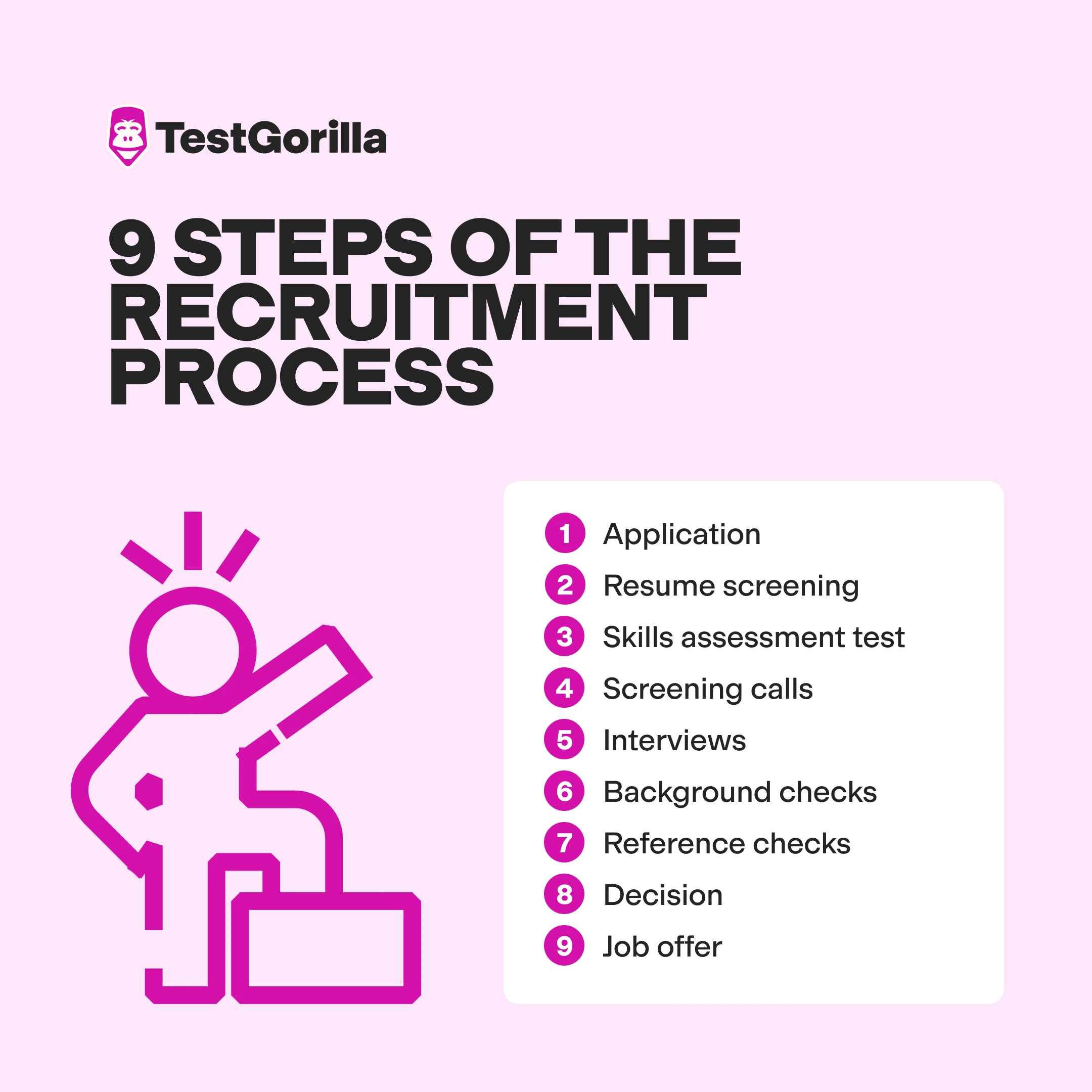
The 15 most effective employee selection methods for recruiters and hiring managers
Find top talent in less time with talent assessments
The employee selection process is crucial. Efficient, high-quality hiring is the difference between a successful business and one that lags.
Without effective screening techniques and pre-employment assessments, you risk costly mis-hires and a drop in productivity and performance – before having to start the entire recruitment process over.
This article provides the best employee selection methods and a step-by-step recruitment guide to help you hire the right candidate the first time.
Table of contents
- What are employee selection methods?
- The 15 best employee selection methods
- The 9 steps of the candidate recruitment process
- Hire better with TestGorilla’s employment selection assessments
- Employee selection methods FAQs
What are employee selection methods?
Employee selection methods are techniques organizations use to identify, screen, and hire suitable candidates for open roles. These methods verify skills and competencies in different ways to get an accurate, holistic view of new hires.
For example, using two employee selection methods, like multi-measure talent assessments and job interviews, gives insights into the following:
Cognitive abilities
Technical skills
Soft skills
Cultural alignment
The right assessment tools enable you to effortlessly verify skills, making a massive positive impact on your employee selection strategy. Consider the hiring budget of your organization and your available resources, like people and time, to choose the best methods.
The 15 best employee selection methods
Here’s our list of the top selection techniques for making hiring decisions, including skills tests, job trials, and structured interviews. Choose the best methods for your organization to screen better candidates and fill open roles effectively.
1. Soft skills tests
Soft skills tests are essential in the candidate selection process. These competencies are vital – 97% of employers say that soft skills are equally important or more important than hard skills, and 89% of mis-hires stem from a lack of soft skills.
Successful employees need problem-solving and communication skills, but they’re impossible to discover through resumes.
Here are three examples of soft skills tests:
Test | Quick description |
Time Management test | Assesses how a candidate handles multiple projects and organizes their schedule |
Communication test | Gauges a candidate’s ability to clearly communicate through verbal, written, and nonverbal methods |
Critical Thinking test | Measures how an applicant uses logical reasoning to weigh arguments and solve problems, as seen in the example question below |
Adam Hartles, the Technical Services Manager at Solid Solutions Management, believes talent assessments are the ideal way to discover soft skills:
“We prioritize soft skills and personality, especially early in the hiring process. Assessments support our initial impressions and reveal any surprises we might not have discovered during the interview.”
2. Hard skills tests
Hard skills tests verify if candidates can complete role-specific tasks successfully. They’re effective and open your doors to a wealth of talented workers.
Too often, companies screen applicants for these skills by looking for college degrees, but this narrows your talent pool by millions. Skilled through alternative routes (STAR) candidates don’t possess traditional certifications, and they represent 60% of the workforce.
Here are a few examples of hard skills tests for a variety of roles:
Test | Suitable roles | Quick description |
Project Management test | Project managers, operations managers, consultants | Assesses the ability to deliver high-quality projects and manage stakeholders |
Microsoft Excel (General) test | Data analysts, admin assistants, accountants, HR managers | Measures how a candidate manages data, manipulates tables, and uses formulas |
Sales Aptitude test | Sales representatives, account executives, customer service representatives | Gauges relationship-building, problem-solving, and sales communication with questions like the one below |
See our talent assessments in action by checking out preview questions for the Sales Aptitude test.
3. Internal hiring
Moving a worker from one role to another is a great way to fill a role without complex hiring campaigns and external recruitment. Plus, they already know company policies and culture.
Internal hiring also engages and motivates your human resources, showing them they have room to grow in the company.
Talent assessments improve internal recruitment and make the selection of employees easy. Skills tests verify competencies objectively, helping you avoid potential bias caused by favoritism or past conflict.
4. Reference checks
Reference checks provide insights and opinions from an applicant’s previous employers, managers, and peers. This input shows you:
What it feels like to work with them
How they tackle day-to-day tasks
The impact they have on colleagues
While talent assessments and interviews give you a better understanding of candidates’ skills, reference checks give you an idea of what the person is like in the workplace.
5. Work sample assignments
Work samples are a great way to see how well candidates perform on the job. Unlike resume screening, these samples give you tangible information on their actual skills and knowledge.
For example, some companies test programming skills for software engineer roles with sample coding assignments or assess copywriting skills with a short pitch for a product.
Ensure you’re transparent about the details and tell qualified candidates the estimated completion time and total payment for the sample.
Alternatively, talent assessments accomplish the same goal as work samples, but they’re easier and more affordable to issue.
6. Job trials
A job trial, also called probation, is one of the best selection methods for hiring employees. Candidates work for a pre-set period, usually a few days but sometimes as long as a month, and become familiar with the work environment and requirements. Afterward, the hiring team decides whether or not to recruit them.
While effective, probation periods have a few shortcomings and can be:
Time-consuming
Resource-intensive
Expensive
These trials don’t apply to every role. They’re more common for blue-collar roles that require hard-to-gauge physical skills.
7. Personality tests
Personality and cultural alignment positively impact your team, but they’re difficult to evaluate through traditional employee selection procedures. Using personality assessments lets you easily discover a candidate’s values, preferences, and traits using questions like the one below.
Here are a few of the top personality and culture tests:
Big 5 (OCEAN) test: Provides insights into a candidate’s behaviors, how they interact with others, and their primary strengths
DISC test: Evaluates an applicant’s motivations and their reactions in group settings
Culture Add test: Assesses if a candidate’s values align with company culture while considering diverse behaviors that could benefit your organization – the opposite of cultural fit
Start personality testing
Gauge candidates’ personalities and behavioral traits today. Sign up for our Free forever plan and gain unlimited access to the Big 5 (OCEAN) test.
8. Phone screenings
Phone screenings are common in employee selection and recruitment and can be a great way to assess potential employees before you invite them to a formal interview. They help you get to know the person better and give a deeper understanding of their communication style.
However, these calls are time-consuming, so some hiring managers skip this step and use talent assessments instead. Skills tests are efficient and provide an accurate picture of candidate skills. They also don’t open the door for biases stemming from awkward conversations.
9. Structured interviews, virtual or in-person
Structured interviews are when you ask every shortlisted candidate the same questions in the same order. A structured approach helps you compare candidates’ responses based on predetermined criteria to find out who has the highest potential.
They’re the most effective type of job interview, reducing unconscious bias and uncovering more information about skills and competencies.
We recommend combining this technique with talent assessments. Use skills test results to ask probing questions and dig deeply into a candidate’s capabilities.
10. Internships
Paid internships are a great way to find new employees. Teach your interns or apprentices how to work successfully as they get to know the company. Both sides of the partnership can gauge whether it’s a good match.
After someone completes an internship, you can transition them into an open role smoothly, which provides them with excellent industry experience, gives the organization new hires, and boosts employer branding.
Just make sure to provide interns with the right mentors and fair compensation.
11. Boomerang hiring
Boomerang hiring is the concept of re-hiring former employees. These workers are well accustomed to the role, understand what it takes to be successful, and align with organizational values.
You typically see boomerang hiring in the service industry, where seasonal work is common. However, this practice is becoming more popular as more companies increasingly understand the benefits of hiring a former employee who understands the role's demands.
12. Direct hiring
Direct hiring is when a company hires a full-time employee with no third party involved, such as outsourcing or temp agencies. It typically involves in-house HR staff posting on job boards and the company website and then personally screening and hiring applicants.
This process is a large undertaking for some companies but is common for small businesses and startups.
Talent assessments are a great addition to direct hiring. Integrate skills tests into your application process so even a small HR team can quickly and accurately verify skills.
Build a watertight screening process
Skills tests are an objective, bias-free way to hire better employees. Book a live demo with one of our experts and learn how to incorporate them into your recruitment process.
13. Social recruiting channels
Social recruiting refers to using social media platforms and online job boards like LinkedIn to promote open roles at your company. Job seekers love this method – even professionals who aren’t looking for work are open to discussing a job because of a social media ad (42%) or employer outreach (38%).
Post about the opening on the company’s social media and actively engage with commenters, gaining better exposure and boosting your employer branding.
It’s also a good idea to directly reach out to prospective hires. Be professional, tell them about the role, and be respectful if they aren’t interested.
14. Referral networks
Referral networks help you find strong candidates. Your employees are your brand ambassadors who share their experience with others and bring in skilled applicants.
This method also connects you to candidates without a lengthy sourcing process, which is why 55% of companies say employee referral networks reduce hiring costs.
Try using referral incentives to motivate team members, then share new open roles to monitor their network for potential candidates.
15. Reaching out to former applicants
Keep a list of your former candidates – especially those who made it to the last stages of the recruitment process – and reach out to them when you open a new role.
Just because a candidate didn’t get the role two years ago doesn’t mean they’re not qualified now. A former applicant might also be suitable for another position in the company.
A lot can change with time, so stay on good terms by occasionally reaching out to them with valuable resources, advice, or just a quick “hello.”
The 9 steps of the candidate recruitment process
Let’s go through the nine steps in recruitment and selection of staff and how skills-based hiring helps you hire the best people.
1. Application
The first step is employee application. Your team must craft a detailed job description and upload it to the most relevant industry job boards to attract the best candidates.
The goal of the application process isn’t about volume. An accurate job description and a relevant job board ensure you receive targeted applications rather than thousands of misaligned candidates.
However, if you get a high volume of applications, talent assessments help you efficiently shortlist them so you only manage top candidates.
2. Resume screening
Typically, the second step is resume screening, but many companies are starting to remove it from their recruitment strategy. Resumes aren’t a good indicator of job performance– these documents don’t verify skills; they describe competencies in the candidate’s own words.
Organizations realize that decisions based on resumes aren’t ideal and often lead to mis-hires. We recommend you skip this step and go right to skills tests.
3. Skills assessment test
Talent assessments are among the best employee selection methods, giving you accurate insights into candidate skills and personality to confidently recruit your next successful worker.
Finding the right candidate the first time doesn’t just impact company performance; it also has a massive impact on hiring speed and recruitment ROI.
You can use pre-employment tests to widen your top talent pool, too. Remove traditional requirements, like college degrees, and verify skills with skills tests instead to gain access to millions of additional candidates.
Try TestGorilla talent assessments by signing up for our Free forever plan today.
4. Screening calls
Screening calls are a part of the hiring process where the HR manager assesses whether the candidate has all the “must-haves” for the job.
For example, if a job requires a driver’s license, it makes sense to screen candidates for it early on. However, you can streamline this step by using TestGorilla’s Qualifying Questions, which quickly ensure applicants have the necessary qualifications before going to the next step.
5. Interviews
During the interview process, HR managers ask relevant questions to candidates to see if they’re the best match for the open role. Interviews come in different formats, but we recommend a structured interview informed by talent assessment results.
Talent assessments also narrow your choices down so you only interview the best without compromising the candidate’s experience.
Ocean Outdoor UK, a digital advertising firm, dropped one of the two interviews in its hiring process due to the effectiveness of skills tests, saving it five hours of interviews per role and decreasing the rate of unsuccessful hires by 44%.
6. Background checks
Employers often conduct background checks next. This step should be quick and necessary for fact-checking. Check your candidate’s past work experience and verify the claims they made during interviews and on their applications.
Third-party companies perform background checks to validate claims, like college degrees.
7. Reference checks
Some employers like to check candidate references before reaching a decision, which provides them with more insight into an applicant before extending an offer.
This step is optional. Many hiring managers believe references aren’t necessary, so they rely on their screening methods, like the results of talent assessments and interviews.
Some employers also avoid reference checks because they could introduce new opinions from biased colleagues.
8. Decision
Now, it’s time to make a decision. Review your shortlisted candidates and consider the results of your employee selection methods, including talent assessment results and how candidates scored in structured interviews.
Don’t forget to review skills test results and check for the ideal personalities, cultural alignment, and behavioral competencies.
Collaborative hiring helps here – multiple decision-makers weighing in on candidates ensures the decision stays focused and unbiased.
9. Job offer
The last element of the employee selection process is the job offer. Once you’ve decided who your best candidate is, offer them the job, and discuss a starting date. Once you reach an agreement and sign the contract, you can plan for the onboarding process.
Hire better candidates faster
Screen candidates with talent assessments and extend an offer faster. Book a live demo with one of our experts and learn how to quickly fill roles with skills tests.
Hire better with TestGorilla’s employment selection assessments
Hiring can feel daunting, but you can find the best people for your organization with the right employee selection methods.
Talent assessments like the ones in our test library remove the guesswork.
These tests show real talent so you can validate skills, ensure cultural alignment, and hire the right people every time.
Sign up for our Free forever plan and see how you can enhance the candidate selection process with pre-employment tests.
Employee selection methods FAQs
Let’s finish by answering a few questions about employee selection methods.
What is the most popular method for employee selection?
Job interviews are the most popular and common employee selection method. They help hiring managers verify skills and get to know candidates personally. They include in-person interviews and virtual interviews over video calls. However, pre-employment tests are rapidly becoming a contender, offering employers a quick, accurate way to assess candidate aptitude.
How can I know if the candidate possesses the necessary knowledge to perform their duties?
Look beyond job titles and focus on highly relevant skills and competencies. Review talent assessment results and ask probing interview questions to discover if the applicant can perform the specific duty your role requires. It’s also important to write a detailed job description, which filters out unqualified candidates at the start of the process.
How do different employee selection techniques compare in their depth of assessment?
Talent assessments provide the deepest look into candidate aptitude, followed closely by work samples, job trials, and interviews. Pre-employment tests enable applicants to use their skills in realistic situations and apply specific industry knowledge.
How can I reduce the cost of hiring while improving applicant quality?
Focus on quality over quantity
Use social media recruitment
Encourage employee referrals
Craft detailed job descriptions
Use talent assessments to validate skills
Use virtual structured interviews to reduce interviewing time
Build a broad talent pipeline
What are the five major tools used to select employees?
Pre-employment test software to assess candidate skill
Video interviewing tools, offering asynchronous interviews and easy scripts
Applicant tracking systems (ATS) to manage candidate applications
Employee referral tools to provide staff with a simple platform to share open roles
Candidate relationship management software to help HR managers connect with potential candidates and build relationships
Related posts
Top 5 alternatives to Enneagram assessment: Best personality tests for hiring
Employee value proposition: What it is & when you need one
Top 5 alternatives to the 16 Personalities test: Best personality tests for work
You've scrolled this far
Why not try TestGorilla for free, and see what happens when you put skills first.
Latest posts
The best advice on pre-employment testing, in your inbox.
No spam. Unsubscribe at any time.

Hire the best. No bias. No stress.
Our screening tests identify the best candidates and make your hiring decisions faster, easier, and bias-free.
Free resources
This checklist covers key features you should look for when choosing a skills testing platform
This resource will help you develop an onboarding checklist for new hires.
How to assess your candidates' attention to detail.
Learn how to get human resources certified through HRCI or SHRM.
Learn how you can improve the level of talent at your company.
Learn how CapitalT reduced hiring bias with online skills assessments.
Learn how to make the resume process more efficient and more effective.
Improve your hiring strategy with these 7 critical recruitment metrics.
Learn how Sukhi decreased time spent reviewing resumes by 83%!
Hire more efficiently with these hacks that 99% of recruiters aren't using.
Make a business case for diversity and inclusion initiatives with this data.




























